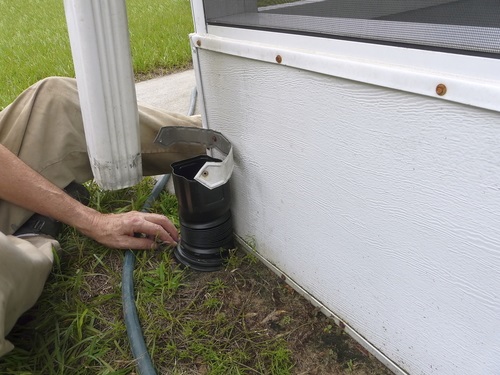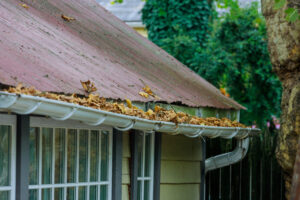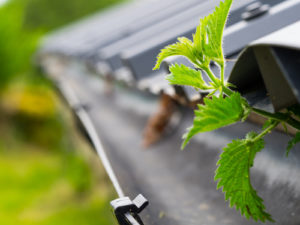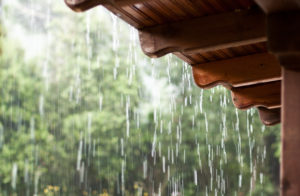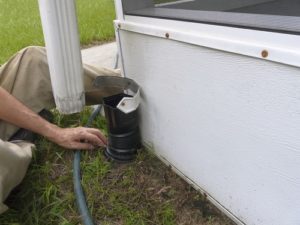 We’ve talked plenty about our K-Guard Leaf-Free Gutter System and how its design prevents everything except water from filling its channels. These maintenance-free gutter systems allow for runoff to smoothly flow through the gutter downspout minus any clogs.
We’ve talked plenty about our K-Guard Leaf-Free Gutter System and how its design prevents everything except water from filling its channels. These maintenance-free gutter systems allow for runoff to smoothly flow through the gutter downspout minus any clogs.
What we haven’t talked much about is where the water goes once it reaches the ground. If it doesn’t fill a rain barrel, naturally irrigate the yard, or create a man-made pond, then where does the water go? In some cases, it goes underground.
Underground Gutter Pipes, Lines, and Drains
Rather than downspouts and splash blocks, some home gutter systems utilize vertical pipes. These connect either via a drain or run directly into an underground line. From there, the water flows away from the home. In some cases, the line goes all the way out to the street, so the water can flow directly into a storm drain.
Utilizing underground drains and pipes is an efficient way to remove excess water from your property. Particularly if it isn’t graded enough to handle dispersion. Most of the time you’re assured the water will flow away from the home and cause no damage.
Like we said. It works most of the time. It’s when it doesn’t work the rest of the time that major problems can occur.
Difficulties that Lead to Disaster
When you have a problem with an external downspout there are several ways to fix it. You can clean and tighten the downspout and extend or redirect where the water goes. If the problem is critical, then you can grade the nearby areas to create a downslope for the water.
Same can be said for the gutters themselves. If they’re clogged, you can clean them out or replace them with a K-Guard Leaf-Free Gutter System. This avoids damage to the gutters, downspouts, and your home.
However, the fix for drains and underground lines is more complex. If clogs or other flow problems aren’t detected and resolved, then the water does different things. If using a drain, the water stays on the property’s surface and eventually pools. Soon enough, you may have foundation damage and basement flooding.
The same thing happens with the underground lines, except on a larger scale. Here, if enough pressure builds behind the clog, two things happen.
First, the water backs up and starts to put pressure on the external pipe. In turn, this might start to fracture or loosen the pipe from the house to cause a major water issue. Plus, the water in the gutters will accumulate.
Since it doesn’t have anywhere else to go, it will splash on the siding to damage the gutter’s soffit and fascia. Further, the gutters can collapse from the water’s weight.
Second, it builds up at the clog point and causes a break in the underground line. Even a small fracture can result in water accumulating in places around the property you never had problems with before. In the end, damage to your landscaping, foundation, and underground rooms could be extensive.
If that isn’t bad enough, you need to pay for the repairs. These won’t be for the pipes alone, which may need to be dug up. It will be for repairs to your home, your yard, and, if they are damaged or destroyed by buildup, your gutter system.
Diagnose Now, Save Later
By diagnosing problems with underground lines and drains ahead of time, you are saving yourself money and time. Even the merest puddle of water in a new location must be a sign of concern. Here are a few things to be pro-active about.
- Check the external pipe. Just like your gutters, the vertical pipes can be clogged by debris. To test, run water from a hose down the pipe from the point where it meets the gutter. If the water backs up, then the clog can probably be removed with a high-pressure hose that delivers water or air. Or, if the clog is near the gutter connection, use a snake to clear it.
- Check the outflow termination. In other words, the point where the water drains into the sewer or drywell. Clearing this of debris should help the water flow better if the issue isn’t with the external pipe.
- Check the underground lines. Follow the same procedure as with the external pipe. However, in this case, you are going to run water from the point where the vertical pipe meets the underground line.
- Replace the pipe. This can be more involved and may require a contractor to come out. First, determine where the problem is. It may not be a nasty clog. Instead, it might be related to a damaged piece of pipe. Once that’s discovered, carefully remove the affected pipe, replace it, make sure it’s watertight, then cover it back up.
And, if you are installing a K-Guard Leaf-Free Gutter system, let our specialists know ahead of time about your drain and underground line setup. They can check the existing area to ensure the gutters and distribution points will work together to keep your property away from drain damage.
Legal and Insurance Considerations with Underground Drains
When installing or maintaining underground gutter systems, homeowners must navigate various legal and insurance issues to ensure compliance and protect their investments. This section delves into the essential aspects of permits, insurance implications, and local regulations related to underground drainage systems.
Permits and Regulations
Before installing underground drains, it is crucial to check local building codes and permit requirements. Many municipalities require permits for drainage work that alters the property’s existing water flow or involves significant excavation. Failure to comply can result in fines and required removal of non-compliant installations. It’s also important to consider easement rights and property lines to avoid disputes with neighbors.
Insurance Implications
Underground gutter systems can impact your homeowner’s insurance policy. Properly installed and maintained systems might reduce premiums by mitigating risks associated with water damage. However, undisclosed or unauthorized modifications to drainage systems could void coverage. Homeowners should consult their insurance provider to understand how underground drainage installations affect their policy, particularly regarding water damage liability and flood insurance requirements.
Compliance with Local Environmental Laws
Some regions have specific regulations aimed at protecting local waterways and managing stormwater runoff. These laws often require that residential drainage systems do not contribute to local flooding or pollution. Ensuring that your underground drains are environmentally compliant not only protects natural resources but also aligns with community efforts to manage water sustainably.
Preventive Maintenance Tips for Underground Gutter Systems with Gutter Guards
Maintaining an underground gutter system is vital to prevent costly repairs and property damage. Integrating gutter guards like the K-Guard Leaf-Free Gutter System can significantly reduce the maintenance needs and enhance the longevity of both the gutters and the underground drainage components.
Benefits of Using Gutter Guards
Gutter guards prevent leaves, twigs, and debris from entering the gutters and subsequently clogging the underground drains. By keeping these materials out, K-Guard systems ensure that water flows freely through the gutters and into the drainage system without obstruction. This not only reduces the frequency of cleanings required but also minimizes the risk of water backing up and causing damage to the property.
Regular Cleaning and Inspection
Even with gutter guards, it is advisable to perform regular inspections and cleanings to ensure that no small debris has bypassed the guard system. Seasonal inspections, particularly in fall and spring, can help catch potential issues early. Homeowners should ensure that the gutter guards are intact and securely in place, and that all entry points to underground drains are clear of obstructions.
Signs of Potential Problems
Be vigilant for signs of clogging or drainage issues, such as water spilling over gutter edges, puddles forming around the property’s foundation, or damp basements. These symptoms may indicate that even with gutter guards, part of the system requires attention. Early detection and remediation can prevent more significant issues down the line.

